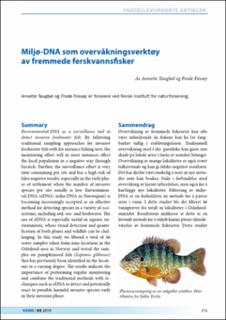Miljø-DNA som overvåkningsverktøy av fremmede ferskvannsfisker
Journal article
Published version

Åpne
Permanent lenke
https://hdl.handle.net/11250/2649018Utgivelsesdato
2019Metadata
Vis full innførselSamlinger
- Scientific publications [1392]
Sammendrag
Overvåkning av fremmede fiskearter kan ofte være utfordrende da fiskene kan ha lav fangbarhet
tidlig i etableringsfasen. Tradisjonell overvåkning med f.eks. garnfiske kan gjøre stor skade på lokale arter i form av uønsket bifangst. Overvåkning av mange lokaliteter er også svært tidkrevende og kan gi falske negative resultater. Det har derfor vært ønskelig å teste ut nye metoder som kan brukes, både i forbindelse med overvåking av kjente utbredelser, men også for å kartlegge nye lokaliteter. Filtrering av miljø-DNA er en forholdsvis ny metode for å påvise arter i vann. I dette studiet ble det filtrert 46
vannprøver fra totalt ni lokaliteter i Oslofjordområdet. Resultatene indikerer at dette er en
lovende metode for å enkelt kunne påvise tilstedeværelse av fremmede fiskearter. Dette studiet
bruker solabbor som eksempel, men metodene kan enkelt overføres til andre arter av interesse
ved bruk av andre artsspesifikke markører. Environmental-DNA as a surveillance tool to detect invasive freshwater fish. By following traditional
sampling approaches for invasive freshwater fish with for instance Fishing nets, the
monitoring effort will in most instances effect the local population in a negative way through bycatch. Further, the surveillance effort is very time consuming per site and has a high risk of false negative results, especially in the early phase of settlement when the number of invasive species per site usually is low. Environmental- DNA (eDNA/ miljø-DNA in Norwegian) is becoming increasingly accepted as an effective
method for detecting species in a variety of ecosystems, including soil, sea- and freshwater.
The use of eDNA is especially useful in aquatic environments, where visual detection and quantification
of both plants and wildlife can be challenging.
In this study we filtered a total of 46 water samples taken from nine locations in the Oslofjord-area in Norway and tested the samples on pumpkinseed fish (Lepomis gibbosus) that has previously been identified in the locations to a varying degree. The results indicate the importance of performing regular monitoring and combine the traditional methods with techniques such as eDNA to detect and potentially
react to possible harmful invasive species early in their invasion phase.